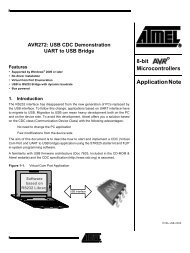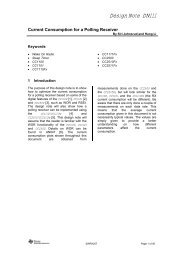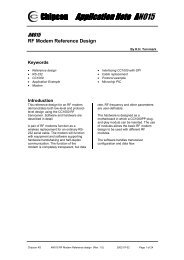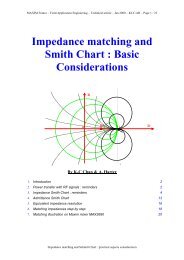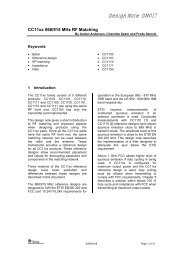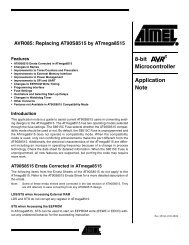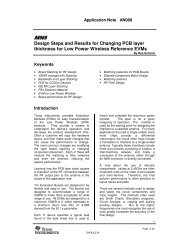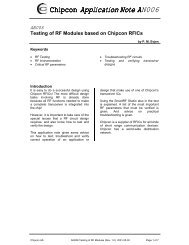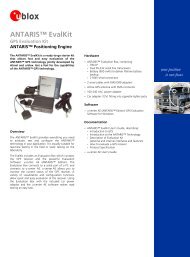AN043 -- Small Size 2.4 GHz PCB antenna_1_2 (Rev. B
AN043 -- Small Size 2.4 GHz PCB antenna_1_2 (Rev. B
AN043 -- Small Size 2.4 GHz PCB antenna_1_2 (Rev. B
- No tags were found...
You also want an ePaper? Increase the reach of your titles
YUMPU automatically turns print PDFs into web optimized ePapers that Google loves.
Application Note <strong>AN043</strong><strong>Small</strong> <strong>Size</strong> <strong>2.4</strong> <strong>GHz</strong> <strong>PCB</strong> <strong>antenna</strong>By Audun Andersen1 KEYWORDS• CC25xx• CC24xx• <strong>PCB</strong> <strong>antenna</strong>• USB dongle• <strong>2.4</strong> <strong>GHz</strong>• Inverted F Antenna2 INTRODUCTIONThe <strong>PCB</strong> <strong>antenna</strong> used on the CC2511USB dongle reference design is describedin this application note. Even if the<strong>antenna</strong> presented is for a USB dongledesign it can be used in all <strong>2.4</strong> <strong>GHz</strong>designs, especially where small space isrequired for the <strong>antenna</strong>.This application note describes the<strong>antenna</strong> dimensions, the RF performanceand considerations for complying withregulatory limits when using this design.The suggested <strong>antenna</strong> design requiresno more than 15.2 x 5.7 mm of space andensures a VSWR ratio of less than 2across the <strong>2.4</strong> <strong>GHz</strong> ISM band whenconnected to a 50 ohm source.Figure 1: CC2511 USB dongleApplication Note <strong>AN043</strong> SWRA117b Page 1 of 22
Application Note <strong>AN043</strong>Table of Contents1 KEYWORDS ................................................................................................................... 12 INTRODUCTION............................................................................................................. 13 ABBREVIATIONS........................................................................................................... 24 ANTENNA DESIGN........................................................................................................ 34.1 DESIGN GOALS........................................................................................................... 34.2 SIMULATION............................................................................................................... 34.3 LAYOUT AND IMPLEMENTATION.................................................................................... 45 TEST RESULTS ............................................................................................................. 55.1 REFLECTION .............................................................................................................. 55.2 RADIATION PATTERN .................................................................................................. 65.3 OUTPUT POWER....................................................................................................... 155.4 SPURIOUS EMISSION AND HARMONICS ....................................................................... 176 CONCLUSION .............................................................................................................. 207 GENERAL INFORMATION .......................................................................................... 217.1 DOCUMENT HISTORY................................................................................................ 21IMPORTANT NOTICE............................................................................................................. 223 ABBREVIATIONSCADCC24xxCC25xxIFAISMLOS<strong>PCB</strong>PERVSWRComputer Aided DesignCC2400, CC2420, CC2430 and CC2431CC2500, CC2510, CC2511 and CC2550Inverted F AntennaIndustrial, Scientific and MedicalLine Of SightPrinted Circuit BoardPacket Error RateVoltage Standing Wave RatioApplication Note <strong>AN043</strong> SWRA117b Page 2 of 22
Application Note <strong>AN043</strong>4 ANTENNA DESIGNThe <strong>PCB</strong> <strong>antenna</strong> on the CC2511 USB dongle reference design is a meandered Inverted FAntenna (IFA). The IFA was designed to match an impedance of 50 ohm at <strong>2.4</strong>5 <strong>GHz</strong>. Thusno additional matching components are necessary.4.1 Design goalsThe reflection at the feed point of the <strong>antenna</strong> determines how much of the applied power isdelivered to the <strong>antenna</strong>. A reflection of less than -10 dB across the <strong>2.4</strong> <strong>GHz</strong> ISM band, whenconnected to a 50 ohm source, was a design goal. Reflection of less than -10 dB, or VSWRless than 2, ensures that more than 90% of the available power is delivered to the <strong>antenna</strong>.Bandwidth is in this document defined as the frequency band where more than 90% of theavailable power is delivered to the <strong>antenna</strong>. Another design goal was to fit the size of the <strong>PCB</strong><strong>antenna</strong> on a USB dongle and to obtain good performance also when the dongle isconnected to a computer.4.2 SimulationIE3D from Zeland, which is an electromagnetic simulation tool, was used to design the<strong>antenna</strong>. The accuracy of the simulation is controlled by the mesh. An increase of the meshincreases the simulation time. Thus, for initial simulations mesh = 1 should be used. When afairly good result is achieved a higher mesh should be used to obtain more accurate results.Comparison of simulation and measurement results shows that the measured reflection isbetween the result obtained with mesh = 5 and mesh = 1; see Figure 2 for details.Figure 2: Comparison of simulation and measurements results.Application Note <strong>AN043</strong> SWRA117b Page 3 of 22
Application Note <strong>AN043</strong>4.3 Layout and implementation<strong>Small</strong> changes of the <strong>antenna</strong> dimensions may have large impact on the performance.Therefore it is strongly recommended to make an exact copy of the reference design toachieve optimum performance. The easiest way to implement the <strong>antenna</strong> is to import thegerber or DXF file showing the <strong>antenna</strong> layout. These files are named IFA_USB.spl andIFA_USB.dxf respectively and are included in the CC2511 USB dongle reference designavailable from http://www.ti.com\lpw. The imported file can be used as a template whendrawing the <strong>antenna</strong>. By using this procedure it should be possible to make an exact copy. Ifthe <strong>PCB</strong> CAD tool being used does not support import of DXF or gerber files, Figure 3 andTable 1 should be used to ensure correct implementation. It is recommended to generate agerber file for comparison with IFA_USB.spl when making a manual implementation. Mostgerber viewers have the possibility to import several gerber files at the same time. Thus byplacing the gerber file, showing the manually implemented <strong>antenna</strong>, on top of IFA_USB.spl itis easy to verify that the <strong>antenna</strong> is correctly implemented. It is also recommended to use thesame thickness and type of <strong>PCB</strong> material as used in the reference design. Information aboutthe <strong>PCB</strong> can be found in a separate readme file included in the reference design. Tocompensate for a thicker/thinner <strong>PCB</strong> the <strong>antenna</strong> could be made slightly shorter/longer.Figure 3: Antenna dimensionsL1 3.94 mmL2 2.70 mmL3 5.00 mmL4 2.64 mmL5 2.00 mmL6 4.90 mmW1 0.90 mmW2 0.50 mmD1 0.50 mmD2 0.30 mmD3 0.30 mmD4 0.50 mmD5 1.40mmD6 1.70 mmTable 1: Antenna dimensions.Application Note <strong>AN043</strong> SWRA117b Page 4 of 22
Application Note <strong>AN043</strong>5 TEST RESULTSReflection, radiation pattern and variation of output power across a wide frequency band weremeasured to verify the performance of the <strong>PCB</strong> <strong>antenna</strong>. Measurements of the dongle in freespace and when connected to a laptop were performed to verify that the <strong>antenna</strong> is suitableboth for USB dongle designs and in a standalone application. Free space is in this documentinterpreted as a measurement performed without connecting the dongle to a computer. Insuch a measurement the dongle is only powered by a battery.5.1 ReflectionAll the reflection measurements were performed with a network analyzer connected to asemi-rigid coax cable, which was soldered to the feed point of the <strong>antenna</strong>. Because of thesmall size <strong>antenna</strong> and the small ground plane this kind of measurements is heavily affectedby the presence and placement of the coax cable. This influence can result in a smalluncertainty in resonance frequency and measured reflection. Typically different placement ofthe semi-rigid coax cable could change the resonance frequency with 5 -10 MHz and thereflection with 3 - 4 dB.Figure 4: Influence of plastic encapsulation and test pins.Application Note <strong>AN043</strong> SWRA117b Page 5 of 22
Application Note <strong>AN043</strong>A small part on the CC2511 USB dongle <strong>PCB</strong> is equipped with test pins. These are intendedfor use during development. This part of the <strong>PCB</strong> will typically be omitted in a final application.The red and green graph on Figure 4 shows that removing this part of the <strong>PCB</strong> has a smallimpact on the performance. Figure 4 also shows that plastic encapsulation of the dongle willshift the resonance frequency to a lower frequency. This can be compensated by making the<strong>antenna</strong> slightly shorter.The size of the ground plane affects the performance of the <strong>PCB</strong> <strong>antenna</strong>. Connecting theUSB dongle to a computer increases the size of the ground plane and thus the performanceis affected. Figure 5 shows how the performance is affected when the USB dongle isconnected to a laptop. In free space the <strong>antenna</strong> has a bandwidth of approximately 250 MHz.When the USB dongle is connected to the laptop the bandwidth is reduced to around 100MHz, which still is enough to cover the whole <strong>2.4</strong> <strong>GHz</strong> ISM band.Figure 5: Comparison of performance.5.2 Radiation patternThe radiation pattern for the <strong>antenna</strong> implemented on the CC2511 USB dongle referencedesign has been measured in an anechoic chamber. Figure 7 through Figure 12 showsradiation patterns for three planes, XY, XZ and YZ, measured with vertical and horizontalpolarization. All these measurement were performed without connecting the dongle to acomputer. Figure 13 and Figure 14 shows the radiation pattern when the dongle is connectedApplication Note <strong>AN043</strong> SWRA117b Page 6 of 22
Application Note <strong>AN043</strong>to a laptop. All measurements were performed with 0 dBm output power. Figure 6 shows howthe different radiation patters are related to the positioning of the <strong>antenna</strong>.X0°YZXY planeYZ planeXZ planeFigure 6: How to relate the <strong>antenna</strong> to the radiation patterns.Application Note <strong>AN043</strong> SWRA117b Page 7 of 22
Application Note <strong>AN043</strong>Figure 7: USB dongle XY plane.Application Note <strong>AN043</strong> SWRA117b Page 8 of 22
Application Note <strong>AN043</strong>Figure 8: USB dongle XY plane.Application Note <strong>AN043</strong> SWRA117b Page 9 of 22
Application Note <strong>AN043</strong>Figure 9: USB dongle XZ plane.Application Note <strong>AN043</strong> SWRA117b Page 10 of 22
Application Note <strong>AN043</strong>Figure 10: USB dongle XZ plane.Application Note <strong>AN043</strong> SWRA117b Page 11 of 22
Application Note <strong>AN043</strong>Figure 11: USB dongle YZ plane.Application Note <strong>AN043</strong> SWRA117b Page 12 of 22
Application Note <strong>AN043</strong>Figure 12: USB dongle YZ plane.Application Note <strong>AN043</strong> SWRA117b Page 13 of 22
Application Note <strong>AN043</strong>Figure 13: USB dongle in laptop XY plane.Application Note <strong>AN043</strong> SWRA117b Page 14 of 22
Application Note <strong>AN043</strong>Figure 14: USB dongle in laptop XY plane.5.3 Output powerTo make a realistic bandwidth measurement of the <strong>antenna</strong> a small test program was used.The test program stepped the center frequency of a carrier from 2.3 to 2.8 <strong>GHz</strong>. Thisbandwidth measurement was also done to verify the result from the reflection measurements,described in section 5.1. The output power was measured using max hold on a spectrumanalyzer. CC2511 was programmed for 0 dBm output power and the <strong>antenna</strong> washorizontally oriented and directed towards the receiving <strong>antenna</strong>. This corresponds to 0° inthe XY plane on Figure 6. The bandwidth measurements were not performed with acorrection factor on the spectrum analyzer. Thus, the results in Figure 15 and Figure 16 onlyshow the relative changes in output power and not the actual level.Figure 15 shows the bandwidth of the <strong>antenna</strong> when the dongle is not connected to acomputer. The result shows that the <strong>antenna</strong> has a variation in output power of less than 3 dBacross a frequency band of more than 350 MHz. This demonstrates that the <strong>antenna</strong> has aApplication Note <strong>AN043</strong> SWRA117b Page 15 of 22
Application Note <strong>AN043</strong>broadband characteristic. Maximum output power is measured to be at 2.54 <strong>GHz</strong>. Thus if thesame <strong>antenna</strong> is implemented on a <strong>PCB</strong> with similar size and if the application is onlyintended for stand alone usage the <strong>antenna</strong> could be made slightly longer to obtain bestperformance at <strong>2.4</strong>2 <strong>GHz</strong>.Figure 15: Output power, USB dongle.The reflection results in Figure 5 indicate that the output power will be slightly reduced whenthe dongle is connected to a laptop. Comparison of the results in Figure 15 and Figure 16shows that the output power is reduced by approximately 2 dB when the dongle is connectedto a laptop. This agrees with the results in Figure 5.Application Note <strong>AN043</strong> SWRA117b Page 16 of 22
Application Note <strong>AN043</strong>Figure 16: Output power, USB dongle in laptop.5.4 Spurious emission and harmonicsTable 2 shows measured output power and emission at the second harmonic. Above thesecond harmonic no peaks were detected when measuring TX emission. This can be seenfrom Figure 17 and Figure 18. These measurements were performed according to FCCrequirements. An approximate conversion to dBm can be done by subtracting 95 from themeasured value in dBµV/m. Since the measurement setup for ETSI and FCC is different thisconversion will not give an exact result, but typically it will give a result that is within 1-2 dB ofthe result from a correct ETSI measurement.Output power <strong>2.4</strong>4 <strong>GHz</strong> 4.88 <strong>GHz</strong>1 dBm 96.9 dBµV/m 56.1 dBµV/m0 dBm 96.1 dBµV/m 54.3 dBµV/m-2 dBm 93.1 dBµV/m 52.5 dBµV/mTable 2: Measured level of output power and harmonics.ETSI and FCC limits for output power and TX spurious emission are shown in Table 3. FCCallows for up to 20 dB higher emission if duty cycling is used. Thus, it is possible to use the<strong>antenna</strong> described in this document and be compliant with both ETSI and FCC regulation.Application Note <strong>AN043</strong> SWRA117b Page 17 of 22
Application Note <strong>AN043</strong>EN 300 328 EN 300 440 FCC 15.247 FCC 15.249<strong>2.4</strong> – <strong>2.4</strong>83 <strong>GHz</strong> 20 dBm 10 dBm* 125 dBµV/m 94 dBµV/m116 dBµV/m**2. harm -30 dBm -30 dBm 54 dBµV/m 54 dBµV/m*Dependent on the power class.** Dependent on the number of channels being used.Table 3: ETSI and FCC limitsFigure 17: TX spurious emission 1 – 5 <strong>GHz</strong>.Application Note <strong>AN043</strong> SWRA117b Page 18 of 22
Application Note <strong>AN043</strong>Figure 18: TX spurious emission 5.5 – 8.5 <strong>GHz</strong>.As opposed to FCC, ETSI has specific RX emission requirements. Table 4 and Table 5 listthe ETSI RX spurious requirements.Narrowband spurious emission Wideband spurious emission30 MHz to 1 <strong>GHz</strong> -57 dBm -107 dBm/Hz1 <strong>GHz</strong> to 12.75 <strong>GHz</strong> -47 dBm -97 dBm/HzTable 4: EN 300 328 RX spurious requirements.25 MHz to 1 <strong>GHz</strong> -57 dBm1 <strong>GHz</strong> to 10 times the carrier frequency* -47 dBm*Applies for equipment operating between 1 <strong>GHz</strong> and 20 <strong>GHz</strong>.Table 5: EN 300 440 RX spurious requirements.The only signal detected above the noise floor when measuring RX spurious emission wasthe VCO leakage at 4.89 <strong>GHz</strong>. Figure 19 shows that the measured VCO leakage is belowETSI limits.Application Note <strong>AN043</strong> SWRA117b Page 19 of 22
Application Note <strong>AN043</strong>Figure 19: RX spurious emission.6 CONCLUSIONThis application note shows that it is possible to implement a <strong>2.4</strong> <strong>GHz</strong> <strong>antenna</strong> on a smallarea and still achieve good performance. Table 6 lists the most important properties of theInverted F Antenna, described in this document. The free line of sight (LOS) range wasmeasure with 250 kbps and 1 % PER.Gain in XY planeGain in XZ planeGain in YZ planeGain in XY plane, connected to laptopLOS rangeAntenna sizeTable 6: IFA properties.4.5 dB5.3 dB5.3 dB3.3 dB240 m15.2 x 5.7 mmThe results provided in section 5 shows that it is possible to comply with both ETSI and FCCregulations when implementing the suggested <strong>antenna</strong> together with CC2511 on a USBdongle.Application Note <strong>AN043</strong> SWRA117b Page 20 of 22
Application Note <strong>AN043</strong>7 GENERAL INFORMATION7.1 Document History<strong>Rev</strong>ision Date Description/ChangesSWRA117b 2007-06-01 Changed name of documentSWRA117a 2007-01-08 Added more dimensions on Figure 3 and Table 1.SWRA117 2006-11-28 Initial release.Application Note <strong>AN043</strong> SWRA117b Page 21 of 22




